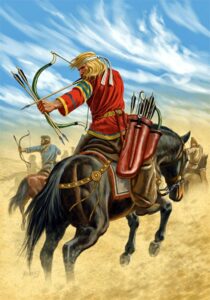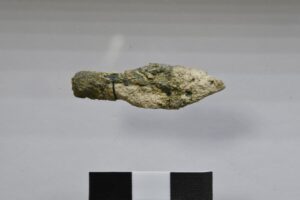Truth:
 The title, By the Waters of Babylon, was taken directly from Psalm 137:1 as part of the lament sung by captives from Jerusalem. Imagine soldiers forcing them to sing during the 400+ mile trek to Babylon after Nebuchadnezzar and his mercenaries completely razed God’s Holy City (Zion).
The title, By the Waters of Babylon, was taken directly from Psalm 137:1 as part of the lament sung by captives from Jerusalem. Imagine soldiers forcing them to sing during the 400+ mile trek to Babylon after Nebuchadnezzar and his mercenaries completely razed God’s Holy City (Zion).
“By the waters of Babylon, there we sat down and wept, when we remembered Zion.” Psalm 137:1
Fiction:
This was the first book I’d ever written in which both main characters were fictional. Merari, the heroine, is a harp maker in Jerusalem and cousin of the biblical prophet, Jeremiah. My novel recounts much of the story told in the Bible’s Book of Jeremiah and the fulfilling of his prophecy that Jerusalem, along with God’s Holy Temple, would be utterly destroyed.
When a band of Scythian mercenaries breaks through Jerusalem’s walls after a three-year siege, their leader–Prince Idan, the fiercest of the mercenary Scythians–scavenges for treasure among the disease-ridden and starving survivors. Amid the chaos, he discovers Merari, who looks like the idols he’s seen of his Scythian goddess, Tabiti. Before issuing the order to burn the city and its golden Temple, he rescues Merari, believing she is Tabiti in human form.
Prince Idan also believes his personal Tabiti is the key to stealing Scythia’s throne from his father. To that end, he determines to march all of Jerusalem’s prisoners to Babylon, and then demand King Nebuchadnezzar give him Tabiti as a war prize.
When Merari learns the cruel Scythians plan to take her to Babylonia, she stops fighting captivity. Having watched the Babylonians take her harp-maker husband captive eleven years ago, she is also determined to go to Babylon–but to find her husband there–or die trying.
Truth:
Scripture describes three exportations of captives from Jerusalem:
- Daniel 1:1–4 describes Babylon’s initial attack on Jerusalem and how they captured King Jehoiakim and the best of Judah’s young men.
- 2 Kings 24:1-17 describes the second siege on Jerusalem when the majority of its gifted artisans and high-ranking nobility were taken.
- 2 Kings 24:18-25:12 is only one of the descriptions of the horrifying and total destruction of God’s chosen city and the Temple in which His presence dwelt. 2 Kings 24:18 specifically mentions that the final destruction occurred eleven years after the second invasion.
More Truth–Why Scythian Soldiers?

Who were the Scythians, and why did I choose them as the mercenaries that aided Nebuchadnezzar in destroying Jerusalem?
Scythians were incredibly skilled horsemen and archers who were a nomadic tribe scattered throughout the north and northeast of Babylon. (photo attribution: https://www.pinterest.com/pin/18014467254595814/)
“For this is what the Sovereign Lord says: ‘From the north I am going to bring against Tyre Nebuchadnezzar king of Babylon, king of kings, with horses and chariots, with horsemen and a great army.'” Ezekiel 26:7
Nebuchadnezzar used these conscripted northern armies as his mercenaries when his empire grew–and they became accomplices in Jerusalem’s demise.
“The Lord sent Babylonian, Aramean, Moabite and Ammonite raiders against him to destroy Judah, in accordance with the word of the Lord proclaimed by his servants the prophets.” 2 Kings 24:2
The Lord had warned His people for centuries, but their continuing disregard for His love and patience had finally reached its limit–in the form of Nebuchadnezzar’s never-before-matched army.
Scythian Facts:

The Scythian goddess, Tabiti, is at the top of their ancient pantheon. She was often pictured (or carved) with a mirror in her hand, so Merari is given a mirror in the story, and it becomes a point of tension in my story.
For more information on the chief goddess of the Scythians and how they might have mistaken a forlorn Jewish woman as their goddess incarnate, CLICK HERE, and scroll down the page to the section on “Tabiti”. (image attribution: Sandra M. Stanton, https://goddessmyths.com/)
Truth:
First Captive Sweep:
 In my novel, Of Fire and Lions, you can read more about how Nebuchadnezzar took Daniel and his three friends from Jerusalem with the first wave of captives in 605 B.C. The Hebrew young men Hananiah, Mishael, and Azariah were later given Babylonian names: Shadrach, Meshach, and Abednego.
In my novel, Of Fire and Lions, you can read more about how Nebuchadnezzar took Daniel and his three friends from Jerusalem with the first wave of captives in 605 B.C. The Hebrew young men Hananiah, Mishael, and Azariah were later given Babylonian names: Shadrach, Meshach, and Abednego.
“In the third year of the reign of Jehoiakim king of Judah, Nebuchadnezzar king of Babylon came to Jerusalem and besieged it…Then the king ordered Ashpenaz, chief of his court officials, to bring into the king’s service some of the Israelites from the royal family and the nobility…Among those who were chosen were some from Judah: Daniel, Hananiah, Mishael and Azariah.” Daniel 1:1–7
Second Captive Sweep:
Babylon returned to Judah a few years later, when King Jehoiakim refused to pay him tribute, and King Neb took a much larger group of captives from the whole nation of Judah. They took the prophet Ezekiel in that group of exiles (yes, even God’s faithful were swept away with the faithless). I’ve recently read a fabulous novel about Ezekiel’s time in Babylon called, Ezekiel’s Song, that I highly recommend.
 Jeremiah, the prophet, remained in Jerusalem and sent a letter to the exiles. Jeremiah 29 gives us some details…
Jeremiah, the prophet, remained in Jerusalem and sent a letter to the exiles. Jeremiah 29 gives us some details…
“This is the text of the letter that the prophet Jeremiah sent from Jerusalem to the surviving elders among the exiles and to the priests, the prophets and all the other people Nebuchadnezzar had carried into exile from Jerusalem to Babylon. (This was after King Jehoiachin and the queen mother, the court officials and the leaders of Judah and Jerusalem, the skilled workers and the artisans had gone into exile from Jerusalem.)… ‘This is what the Lord Almighty, the God of Israel… “Build houses and settle down; plant gardens and eat what they produce. Marry and have sons and daughters; find wives for your sons and give your daughters in marriage…seek the peace and prosperity of the city to which I have carried you into exile. Pray to the Lord for it, because if it prospers, you too will prosper…When seventy years are completed for Babylon, I will come to you and fulfill my good promise to bring you back to this place. For I know the plans I have for you,” declares the Lord, “plans to prosper you and not to harm you, plans to give you hope and a future”.'” Jeremiah 29:1–2, 4-7, 10-11 (emphasis added)
I bolded the types of people Nebuchadnezzar took with him to Babylon:
- elders
- prophets
- priests
- King Jehoiachin
- Queen Mother
- court officials
- other leaders
- skilled workers (carpenters, metal workers, etc)
- artisans (i.e. harp makers – like my fictional character’s husband)
Truth And Fact:
Third Captive Sweep:
The horror of Jerusalem’s destruction cannot be overstated. When Zedekiah, the final king of Judah, rebelled against Nebuchadnezzar, the Babylonian king lost all patience with the proverbial thorn in his side.
“So in the ninth year of Zedekiah’s reign, on the tenth day of the tenth month, Nebuchadnezzar king of Babylon marched against Jerusalem with his whole army. He encamped outside the city and built siege works all around it. The city was kept under siege until the eleventh year of King Zedekiah. By the ninth day of the fourth month the famine in the city had become so severe that there was no food for the people to eat.” 2 Kings 25:1–3
Fact:
 For those who need archaeological evidence, they had to wait until 2019 when academics from the University of North Carolina at Charlotte reported significant finds including: ash deposits, arrowheads, broken pieces of pots and lamps, and a unique piece of jewelry (which appears to be a tassel or earring with a bell-shaped upper portion). The most intriguing find to prove the FICTION in my book was the arrowhead in the photo–pointing to heavy Scythian involvement in Jerusalem’s siege! CLICK HERE to read CNN’s full report.
For those who need archaeological evidence, they had to wait until 2019 when academics from the University of North Carolina at Charlotte reported significant finds including: ash deposits, arrowheads, broken pieces of pots and lamps, and a unique piece of jewelry (which appears to be a tassel or earring with a bell-shaped upper portion). The most intriguing find to prove the FICTION in my book was the arrowhead in the photo–pointing to heavy Scythian involvement in Jerusalem’s siege! CLICK HERE to read CNN’s full report.
Romance Fiction
In every novel, I try to add a little romance. But how could a half-starved Hebrew woman feel any sort of attraction for a brutal, pagan Scythian? Well, it wasn’t easy! And I promise the ending will surprise you–perhaps even shock you. However, after talking with many fellow authors and a couple of editors, they agreed with my gut instinct…it was the only way this story could plausibly, believably end.
We’ll leave it at that…
I hope you’ve enjoyed this FACT OR FICTION page for By the Waters of Babylon. If you haven’t yet read the book and would like to purchase your copy or learn more about it, CLICK HERE. And if you’re curious about the Truth that awaits you in God’s Word, check out Psalm 137, Jeremiah, 2 Kings 23:26, 2 Chronicles 36.
*CLICK HERE for a downloadable list of all my books. Happy reading!


